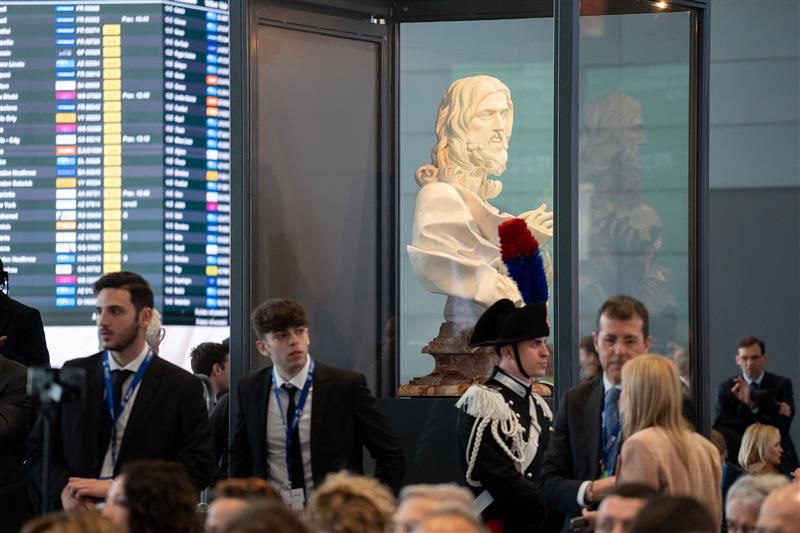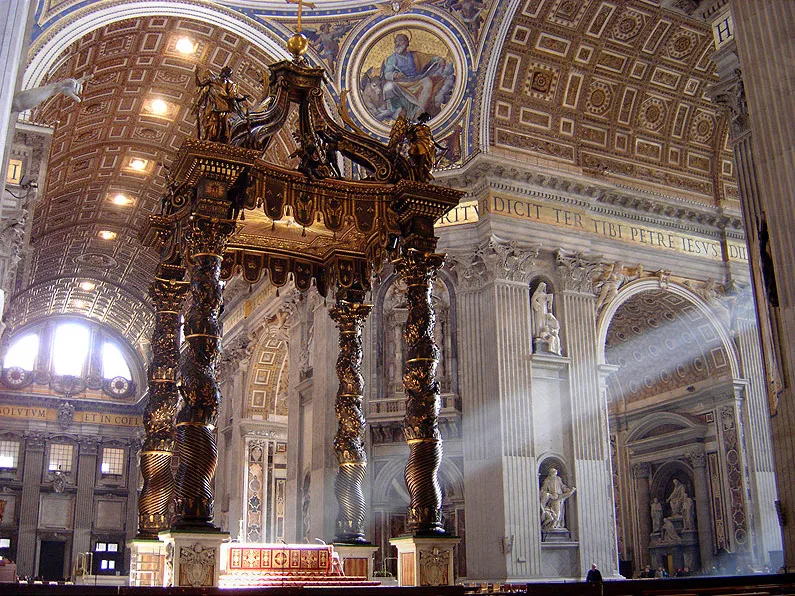
“Everyone is free to express their opinions, but that statue [of St. Nicholas of Myra] is a sign of an historical event and historical events cannot be cancelled.” This is how Fr. Giovanni Distante, prior of the Pontifical Basilica of St. Nicholas in Bari—a city in southern Italy intimately connected with St. Nicholas—responded to the potential removal of a well-loved statue of St. Nicholas. The saint in question is the precursor of St. Nick, or Santa Claus, and is one of the most celebrated Christian saints revered in Eastern and Western churches. And he is a point of unity, healing the schism between Eastern and Western Christianity since the 11th century.
Why is the statue of St. Nicholas at risk of being cancelled?
In 2003, the Russian President Vladimir Putin donated the bronze St. Nicholas statue, the work of the prominent Georgian artist Zurab Konstantinovich Tsereteli, to the city of Bari, with a signed dedication on a plaque honoring the citizens of Bari and the centuries-old unity between Russia and Bari:
May this gift be not only testimony of the veneration of the great Saint by the Russians, but also a constant aspiration of people of our countries consolidating friendship and cooperation.
An online petition, receiving 17,600 signatures, asked for the removal of the plaque as a gesture of solidarity with the Ukrainian people. Others, including Nicola Colaianni, professor of canon law at the University of Bari and former parliamentarian, requested the dismantling and removal of the St. Nicholas statue from the central plaza in front of the basilica, to a discreet place, where visitors would need to specifically go and see it.
As we know by now, cancellations breed cancellations. For example, the University of Milan Biccocca cancelled a course on Fyodor Dostoevsky (the decision was later retracted by the university). As a recent essay in The Atlantic observed, the West is pursuing a “cancel Russia” strategy: “isolating the country with coordinated official sanctions and a rapid cascade of uncoordinated, highly moralized, unilateral private-sector boycotts.”
But what do Saint Nicholas and Fyodor Dostoevsky to do specifically with the current Russian aggression? Why are Christians pitting themselves against Christians? If anything is to be learned from these two distinguished figures, it is that humanity and authentic dialogue are essential to resolving the current conflict.
St. Nicholas has nothing to do with the Russian aggression against Ukraine, but he has a great deal to do with ecumenism and dialogue between Orthodox and Catholics, Byzantine East and Latin West. The popular saint has built bridges of communication between East and West over the centuries, bridges which are still needed to overcome the conflict and open the channels of communication. In the recent words of Pope Francis, “Let the weapons be put down! Let the Easter truce begin.” The same unity is needed for the city of Bari and the citizens of Bari, known as Baresi, who have been divided over the removal of the statue of their beloved saint.
What is Russia’s special bond with St. Nicholas and Bari?
St. Nicholas, the Wonderworker (270-343), from Myra (present day Turkey), according to tradition was one of the participants in the Council of Nicea (325), signed the Nicene Creed, and struck Arius on the face after hearing the famous heretic’s blasphemies against the Son of God. The veneration of St. Nichlas gained prominence in the Byzantine Empire between the 8th and 9th centuries. Churches were dedicated to St. Nicholas, and his icons were recorded to have performed miracles. There is strong historical evidence of dedication to St. Nicholas in Bari—a major stronghold of the Byzantine Empire—before the Norman conquest of the city, and well before the translation of the relics from Myra (Turkey) in 1087. Emperor Constantine IX Monomachos (1042-55) built a church within the city’s walls that placed Bari under St. Nicholas’s protection. At least five churches dedicated to St. Nicholas were erected in Bari and its vicinity before 1087. According to Byzantine sources, St. Nicholas is one of the several saints who appears in the Bari Exultet (a roll containing the hymn sung on Holy Saturday during the blessing of the Paschal candle). St. Nicholas is also reputed as a protector of sailors, a very relevant patronage for a city on Italy’s sea-facing coast.
Christianity reached Russia via Byzantium, and with it so did the cult of St. Nicholas. Thus, Christianity and St. Nicholas went hand in hand in Christianizing Russia. In 1036 a church and monastery were dedicated to the saint in Kiev. Miracles were also related to the icons of the saint in Russia. In 1113, Mstislav I of Kiev, son of Vladimir Monomakh Grand Prince of Kievan Rus’, lost in the woods after hunting, found his way back when he followed a light coming from an icon of St. Nicholas. The Legend of Kiev, written by a contemporary around 1093, examines the reasons of the translation of the relics of “a godly man, the great bishop Saint Nicholas” from Myra (Turkey) to Bari (Italy) in 1087 by 62 sailors:
… The Ismaelites, having already invaded for divine decree and design of the Most High the Greek territory on the other side of the sea, starting from the Khersonese unto Antiochia and Jerusalem, killed every man they would find through all their cities and villages, women and children they took into slavery and burned their houses. They put to sack churches and monasteries, taking the cities under their power. Then they wasted Licia too, where the body of St. Nicholas was resting, precious body, venerable body, performing wondrous and glorious miracles. Couldn’t such a godly man stop the waste of his city and of the churches? But he did not wish to oppose the divine decree. On the contrary, he said: “That the Lord do what is fitting to his eyes.”
The translation of the saint’s relics is celebrated by the Orthodox Church on May 9 and by the Latin Church on May 22. It is worth noting that the translation from Myra to Bari happened 33 years after the so-called schism between the East and West. The veneration of the saint, which has persisted even after the schism, offers the churches a constant reminder of the once-united Christendom. Eleven years after the relics were translated to Bari, Pope Urban II chose Bari and the crypt of St. Nicholas to convene a council where Latin and Greek bishops participated, trying to find consensus on the procession of the Holy Spirit in order to resolve the Filioque controversy.
Historically, St. Nicholas has attracted an uninterrupted flow of pilgrims from the churches of the East, and especially Russian pilgrims. Pilgrimage to the remains of St. Nicholas gained equal importance to the pilgrimage to the tombs of the Apostles Peter and Paul in Rome from faithful coming from the East. Additionally, the city of Bari became a required stop for the pilgrims headed to the Holy Land. As a gesture of unity, just five years ago, the relics were transferred from Bari to Moscow and St. Petersburg, giving millions of Russians the opportunity to venerate these relics before they were returned to Bari.
St. Nicholas is a common patrimony of holiness for East and West; he is not a local but a universal saint—a saint without borders, an ecumenical saint par excellence venerated by Orthodox and Catholics alike. Although the saint has been dead for 1,679 years, his relics and his statue not only bring fresh hope to pilgrims but contribute to what St. John Paul II called healing of historic memories between East and West and fostering ecumenical relations between the Catholic Church and the Eastern Orthodox Churches. This is what Pope Francis defined as ecumenism of prayer, ecumenism of walking. St. Nicholas and his ecumenical story cannot be cancelled. History cannot be rewritten. Removing the statue would not promote peace; instead, it would be an effort to erase a depiction and symbol of a most powerful peace-bringing presence at a time when St. Nicholas’s devotees are in most need of healing.
Ukrainians and Russians could use St. Nicholas and their common, centuries-old veneration for the saint as starting point for dialogue to end the senseless war. Cancelling a symbol of the city which has signified openness and dialogue incites violence and divisions. The statue should be there to stay, as a reminder of the unity St. Nicholas inspired during the most difficult days of division between East and West. His intercession—and the statue, the visible reminder of his intercession—can inspire dialogue and fatherly guidance toward family unity.
If you value the news and views Catholic World Report provides, please consider donating to support our efforts. Your contribution will help us continue to make CWR available to all readers worldwide for free, without a subscription. Thank you for your generosity!
Click here for more information on donating to CWR. Click here to sign up for our newsletter.








To give voice to justice and the Gospel, it would be better for Pontiff Francis to publicly tear up his Havana Accord with the reptile Kirill, to show accord instead with all of the good Orthodox Churches who have condemned Kirill (the Russian Orthodox Patriarch) for blessing the Russian war of atrocity against Ukraine.
Tear up the Havana Accord with Kirill, who is a fraudulent Krisjun.
Thank you. Yes.